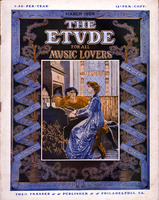The first question is naturally: Where shall we go, and to whom? Berlin swarms with teachers. There are Moser, Wirth, Markees, Wietrowitz, Halier and Joachim at the Hochschule; Witek, Zayic, Frau Scharwenka, Arthur Hartmann, Gustav Hollaender, and many others. Kreisler has taken up his abode there, but is not teaching. In Frankfort one finds Hugo Heermann. In Paris there are Marsick and a corps of assistants. In Geneva is Marteau; in London are Johann Kruse, Wilhelmj, Huboy and others. In Brussels are Ysaye, Musen and César Thomson. In Leipzig is Hans Sitt. In Prague in (sic) Sevcik, the technic-hypnotist. In Russia is Leopold Auer.
A letter from a Berlin student reads as follows:
“Why do we come to Europe? I am sure I don’t know! We can study in America far better, with good artists and under much better climatic and linguistic conditions. We are ground out here by rote and rule. Everything is planned for us, and our only escape from pedantry is to write a free fantasie and send it to an American publisher. Now, the question is a serious one, for our teachers here realize very little the needs of American life. At any rate, we become familiar with the classics here and learn to drink good beer!”
There is a serious reason why American teachers go abroad for supplementary study. It aids us in securing good positions in schools, colleges and conservatories. Very few college presidents like to consider applicants who have studied only in our large American cities. It is a narrow view, but one must consider it if one is to teach.
Speaking of the comparative merits of foreign violin schools, a Boston artist, who has studied in several centres, says: “I found my life in Brussels very congenial. We were, however, obliged to play great concertos until we were fairly worn out. Everything was sacrificed for public appearance. If we could only play these works, get over them, as it were, bowing and tone were of no consequence. Of course, I do not mean that we neglected tone altogether, but we had to play our concertos until we knew them. The Belgian school pays less attention to bowing than to other things.
“In Berlin everything depended on bowing. I was told that I could never be received by Joachim if I did not learn to move my wrist laterally. I was even discouraged from entering the Hochschule because I had not learned to swing my wrist.”
Mr. C. M. Loeffler, formerly of the Boston Symphony Orchestra, has quite recently returned from an extended sojourn in Europe, during which time he investigated thoroughly the work of various schools. Mr. Loeffler thinks that the influence of the Berlin school is waning. While he does not entirely espouse the cause of the Belgian school, he leans to the creed of Ysaye. Of the Prague school he says: “Undoubtedly they make great technicians in Prague, but they neglect tone. After listening to a Prague virtuoso day after day one is struck by the absence of warmth and beauty in tone. The principles laid down by Sevcik are excellent, especially the normal, free development of the left hand, but there is too much attention paid there to mere technic.”
Mr. Whitney, the Boston voice teacher, said some time ago to the present writer: “There are many ways of playing the violin, but there is only one way of singing and that is the right way!”
After investigating the work of several schools, the true artist and teacher will assimilate and apply the best points of each system to his own use. A course of study which suits one pupil will not suit another. For the following out of any one creed we cannot look to great artists. They are too great to be bound down by any creed.
Since teachers must have theories and practical ones, we can only test a principle, and if it is good we can apply it still further to our work. There are good points in most acknowledged systems and schools. —Edith L. Winn.



